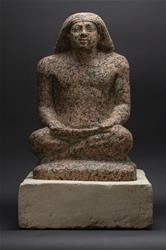The Antiquities Museum Displays Statue of Egyptian Scribe
Posted on

The Bibliotheca Alexandrina displays, in its Antiquities Museum, the statue of Tep-em-Ankh, which represents an Egyptian scribe from the era of the Old Kingdom. The display of this unique antiquity at the museum comes as part of the leading international cultural role played by the BA in light of its cooperation with the Ministry of Tourism and Antiquities, and the National Museum of Egyptian Civilization in Fustat. This statue is also considered to be of great archaeological value and an important addition to the artifacts housed in the BA Antiquities Museum.
The statue dates back to the Fifth or Sixth Dynasty, during the reign of King Unas (also known as Wenis), between 2375 and 2345 BCE, or the reign of King Pepi II, between 2184 and 2278 BCE. The pink granite statue was discovered north of the Step Pyramid of Djoser, and it is installed on a white limestone base. The statue is depicted with a wig covering part of his ears. His face appears very natural, and his features are realistic and serious, as though he is paying attention to what is being dictated to him.
Tep-em-Ankh bore the titles of Minister and Chief Justice, which were among the highest ranks in ancient Egypt, as he was among the most influential state employees. The ancient Egyptian civilization paid great attention to Egyptian scribes throughout the ages, particularly in the era of the Old Kingdom, when the king used to assign the minister the tasks of managing the state's administrative system. In addition, the position of Chief Justice made him the head of the legal administration of the state. Therefore, the enlightening role that the scribe played in the intellectual life in ancient Egypt becomes more prominent.
Since the era of the Old Kingdom (2686–2160 BCE), Egypt had been managed by an educated class of civil servants under the command of the Minister, including the scribes; a prestigious class that played a pivotal role in the Egyptian administration. The scribe was responsible for registering royal decrees and orders, recruiting soldiers into the army, selecting workers for construction, and calculating and collecting taxes. Moreover, they were the keepers of traditions and rituals in Egypt; hence, they were the keepers of history and civilization. The depiction of senior statesmen and nobles in the form of scribes is one of the finest and most sophisticated forms of artistic representation, due to the unique position that scribes enjoyed in ancient Egypt.